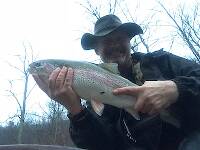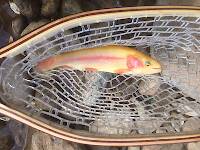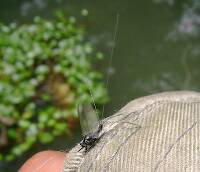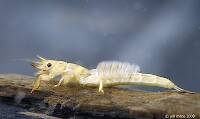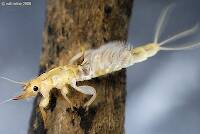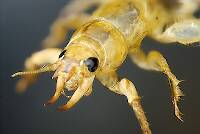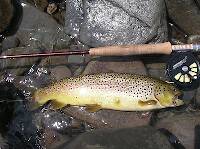
Blue-winged Olives
Baetis
Tiny Baetis mayflies are perhaps the most commonly encountered and imitated by anglers on all American trout streams due to their great abundance, widespread distribution, and trout-friendly emergence habits.
Featured on the forum

This species was fairly abundant in a February sample of the upper Yakima.

Troutnut is a project started in 2003 by salmonid ecologist Jason "Troutnut" Neuswanger to help anglers and
fly tyers unabashedly embrace the entomological side of the sport. Learn more about Troutnut or
support the project for an enhanced experience here.
Troutnut on Jul 23, 2010July 23rd, 2010, 12:05 pm EDT
Here's another interesting piece of science that came to my attention at the symposium in May. It's a different part of the same study I posted in the hooking mortality thread.
They looked at how catchability is affected by various things, and found that fish that have been caught before are actually more likely to be caught again. That means that rather than becoming "educated" fish, some may just be more naive than others and prone to easy capture.
Here's the citation/abstract from Web of Science:
Of course, we have to be a bit careful reading too much into this sort of correlation. It may not be caused simply by naive fish. Bigger fish were also more likely to be caught. It could be that larger, dominant fish are in the best feeding positions, which also happen to be relatively easy for anglers to find and receive more fishing attention.
Also, the study was done with live bait. Maybe fish just can't learn to avoid well-presented live bait, but the picture with artificial flies could be different.
As is often the case with science, there are plenty of caveats and unanswered questions after an interesting study... but that makes it no less interesting!
They looked at how catchability is affected by various things, and found that fish that have been caught before are actually more likely to be caught again. That means that rather than becoming "educated" fish, some may just be more naive than others and prone to easy capture.
Here's the citation/abstract from Web of Science:
Author(s): Tsuboi J, Morita K
Source: FISHERIES RESEARCH Volume: 69 Issue: 2 Pages: 229-238 Published: SEP 2004
Times Cited: 7 References: 37
Abstract: Angling selectivity due to both phenotypic variation and experience of being caught was examined at the individual level in white-spotted charr (Salvelinus leucomaenis) in a multiple catch-and-release experiment in a natural stream. We carried out a field study in a headwater tributary, which is closed to recreational fishing year-round for all species. As the study reach (0.9 km) was located upstream from impassable dams, the white-spotted charr have a non-anadromous life history. After identifying individual fish (n = 415) using numbered anchor tags, eleven fishing episodes at 7-day intervals were conducted using single barbed baited books. Of the 735 marked fish (cumulative count) caught-and-released, 82 deep-hooked fish were released by cutting the line. Only one fish (0.13%) died before release. After these episodes, the experience of being caught of each recaptured fish (n = 366, recapture rate 88.2%, fork length 96-311 mm) ranged from zero to seven times. The number of times caught increased with fork length and age, but was not related to the latest growth or condition factor. In addition, males were caught more often than females. The experience of being caught by angler differed significantly between caught (2.14 +/- 0.25 times) and not caught (1.77 +/- 0.13 times) fish at the 11th fishing episode. A logistic regression analysis was conducted to examine whether eight variables were related to the probability of being caught at the 11th fishing episode. The result suggests that the probability increased with experience of being caught and fork length. Therefore, fish that have been caught and released are more likely to be caught than not caught fish. Our results indicate that catch-and-release regulations can be an effective management tool because anglers may continuously catch fish while conserving fish populations.
(C) 2004 Elsevier B.V. All rights reserved.
Of course, we have to be a bit careful reading too much into this sort of correlation. It may not be caused simply by naive fish. Bigger fish were also more likely to be caught. It could be that larger, dominant fish are in the best feeding positions, which also happen to be relatively easy for anglers to find and receive more fishing attention.
Also, the study was done with live bait. Maybe fish just can't learn to avoid well-presented live bait, but the picture with artificial flies could be different.
As is often the case with science, there are plenty of caveats and unanswered questions after an interesting study... but that makes it no less interesting!
Jason Neuswanger, Ph.D.
Troutnut and salmonid ecologist
Troutnut and salmonid ecologist
Jmd123 on Jul 23, 2010July 23rd, 2010, 1:47 pm EDT
This reminds me of a rousing discussion that has been going on amongst the (at least letter-writing) readers of Fly Rod and Reel magazine (see Letters in the Summer 2010 edition). A reader proposed the idea that catch-and-release fishing is NOT for the benefit of the fish, as we are essentially tormenting them for our own enjoyment. Rather, he states, catch-and-release fishing is for the benefit of the FISHERMAN as it preserves fish populations for us, regardless of whether it is actually good or not for a fish to be caught and released. One fellow even proposed a thought experiment to his colleagues concerning coming up with tiny baited hooks and traps with which to catch small birds and mammals, fight them to near exhaustion, and then release them. He states that his fellows were universally horrified at this idea...
First of all, small birds and mammals are things that humans rarely, if ever, eat - there ain't much meat on a sparrow or a field mouse. Second of all, these little creatures have BIG BROWN EYES that we can relate to the same way we relate to our dogs and cats! Third, as stated in one of these articles, the fish brain is much simpler and probably does not feel pain the same way we do. Realistically, think about the pain caused by hooking a fish in the mouth compared to trying to choke down a big crayfish or stonefly nymph, or a bluegill or perch with all of its spines fully erected! If fish felt much pain in their mouths, these creatures would be safe! Fourth, and perhaps most important, fish suffer "emotional trauma" from the time they pop out of their mothers' bellies - EVERYTHING is trying to EAT THEM, even before they pop out of the eggs! They have to spend their entire lives escaping from near-death experiences at the hands (fins?) of larger fishes, large invertebrates, amphibians, reptiles, wading/diving birds, minks, otters, etc...Apparently, according to the physiological studies Jason has so kindly provided here, being caught and released isn't any different from any other survival situation for these fish because they appear to already be adapted to it. Provided, of course, that the fish are handled CAREFULLY!
Fifth: catch-and-release fishing IS GOOD for the fish because it makes fisherman interested in maintaining GOOD FISHERIES which require GOOD HABITAT for the fish to go forth and multiply in. IS THIS NOT GOOD FOR THE FISH AS WELL?????
Jonathon
First of all, small birds and mammals are things that humans rarely, if ever, eat - there ain't much meat on a sparrow or a field mouse. Second of all, these little creatures have BIG BROWN EYES that we can relate to the same way we relate to our dogs and cats! Third, as stated in one of these articles, the fish brain is much simpler and probably does not feel pain the same way we do. Realistically, think about the pain caused by hooking a fish in the mouth compared to trying to choke down a big crayfish or stonefly nymph, or a bluegill or perch with all of its spines fully erected! If fish felt much pain in their mouths, these creatures would be safe! Fourth, and perhaps most important, fish suffer "emotional trauma" from the time they pop out of their mothers' bellies - EVERYTHING is trying to EAT THEM, even before they pop out of the eggs! They have to spend their entire lives escaping from near-death experiences at the hands (fins?) of larger fishes, large invertebrates, amphibians, reptiles, wading/diving birds, minks, otters, etc...Apparently, according to the physiological studies Jason has so kindly provided here, being caught and released isn't any different from any other survival situation for these fish because they appear to already be adapted to it. Provided, of course, that the fish are handled CAREFULLY!
Fifth: catch-and-release fishing IS GOOD for the fish because it makes fisherman interested in maintaining GOOD FISHERIES which require GOOD HABITAT for the fish to go forth and multiply in. IS THIS NOT GOOD FOR THE FISH AS WELL?????
Jonathon
No matter how big the one you just caught is, there's always a bigger one out there somewhere...
GONZO on Jul 23, 2010July 23rd, 2010, 2:11 pm EDT
The catch-and-release studies are good stuff, Jason, though I'm somewhat less impressed with this one. Fish are individuals, and I have never doubted that some fish are easier to catch than others--for a number of reasons.
This study debunks the rather silly old notion that fish become "uncatchable" after being caught and released, but if that really needed debunking, it is not new. (I recall an old USFWS study on the "recatchability" of cutthroat trout at Buffalo Ford on the Yellowstone that estimated that they were captured an average of 7 times per season.) Beyond that, I'm not sure what conclusions can really be drawn. Even the stated conclusion--"fish that have been caught and released are more likely to be caught than not caught fish"--seems a little like saying that people who get drunk once are more likely to get drunk than people who don't drink. :)
Perhaps the use of bait was a factor, but my guess would be that the results would have been very similar had flies been substituted. In an odd (and surely unintended) way, the study actually seems to support something I have long assumed about the effects of (fly-fishing) pressure having primarily a short-term effect.
The factor that I find most limiting in terms of drawing any meaningful conclusions about the practical effects of fly-fishing pressure and "education" is the 7-day interval between fishing episodes. I strongly suspect that if we could enforce a 7-day non-fishing period between each fishing day nearly all pressure-related resistance to the fly would disappear.
This study debunks the rather silly old notion that fish become "uncatchable" after being caught and released, but if that really needed debunking, it is not new. (I recall an old USFWS study on the "recatchability" of cutthroat trout at Buffalo Ford on the Yellowstone that estimated that they were captured an average of 7 times per season.) Beyond that, I'm not sure what conclusions can really be drawn. Even the stated conclusion--"fish that have been caught and released are more likely to be caught than not caught fish"--seems a little like saying that people who get drunk once are more likely to get drunk than people who don't drink. :)
Perhaps the use of bait was a factor, but my guess would be that the results would have been very similar had flies been substituted. In an odd (and surely unintended) way, the study actually seems to support something I have long assumed about the effects of (fly-fishing) pressure having primarily a short-term effect.
The factor that I find most limiting in terms of drawing any meaningful conclusions about the practical effects of fly-fishing pressure and "education" is the 7-day interval between fishing episodes. I strongly suspect that if we could enforce a 7-day non-fishing period between each fishing day nearly all pressure-related resistance to the fly would disappear.
Konchu on Jul 25, 2010July 25th, 2010, 7:38 am EDT
I didn't read the whole article, but I wonder how consistently certain fish were caught in certain spots. Or, how often the same spot was fished by the researcher(s), resulting in the same fish being caught. If the fish don't stray too far from their "home" area, and take what food is available where they are, well then yes they will be caught again again and again. Seems we may have had a discussion about this a couple of years ago.
This study sounds like it was designed by some crafty scientist-fishermen: Hmmmm...Let's design an experiment so that we can fish waters off limits to everyone else!
This study sounds like it was designed by some crafty scientist-fishermen: Hmmmm...Let's design an experiment so that we can fish waters off limits to everyone else!
Jmd123 on Jul 25, 2010July 25th, 2010, 5:44 pm EDT
I wonder if Konchu hit the nail on the head with regards to this one. "Hey, let's write a grant proposal that allows us to do a LOT of fishing, with all expenses paid, under the auspices of scientific research."
Well, truth be known guys, I was once paid to fish ON THE JOB during our Pigeon River silt spill study. The idea was to prove the worth of the reservoir behind the dam, which everyone in the local flyfishing community wanted REMOVED because of not only the silt spill but also feelings that the dam/reservoir warmed the water, etc. I need to mention here that a dead 22" brown was seen floating downstream after the infamous silt spill. So, I got paid to get out the fly rod and fish for a couple of hours to see what was in the pond that everyone wanted drained. After tying on a #10 copper/brown variant Killer Bass Fly, which I reasoned was a good sculpin imitation, and throwing it around just above the dam for less than 5 minutes, something BIG clamped down on it and took me for a long, deep fight. As I suspected, it was a brown trout in the 20"+ range, which I foolishly lost when I tried to bring it in before it was tired and he wrap-and-snapped me off on the wooden wingwall of the dam (DAMN!!!). Our conclusion from this little exercise in paid fishing was that the dead 22" brown came from ABOVE the dam, got sucked out when the dam accidentally opened (hence the silt spill), and got BRAINED on a rock!! (We also found sedimentation ABOVE the reservoir in our control areas, quite possibly indicating that the dam is in fact a big SILT TRAP and actually GOOD for the river...)
Anyway, that's my paid fishing experience. Also, I once got paid for two entire summers (amongst other work) to float down the AuSable River (MI) in a canoe and interview fisherman as part of a MDNR creel census. Does that count?
Jonathon
Well, truth be known guys, I was once paid to fish ON THE JOB during our Pigeon River silt spill study. The idea was to prove the worth of the reservoir behind the dam, which everyone in the local flyfishing community wanted REMOVED because of not only the silt spill but also feelings that the dam/reservoir warmed the water, etc. I need to mention here that a dead 22" brown was seen floating downstream after the infamous silt spill. So, I got paid to get out the fly rod and fish for a couple of hours to see what was in the pond that everyone wanted drained. After tying on a #10 copper/brown variant Killer Bass Fly, which I reasoned was a good sculpin imitation, and throwing it around just above the dam for less than 5 minutes, something BIG clamped down on it and took me for a long, deep fight. As I suspected, it was a brown trout in the 20"+ range, which I foolishly lost when I tried to bring it in before it was tired and he wrap-and-snapped me off on the wooden wingwall of the dam (DAMN!!!). Our conclusion from this little exercise in paid fishing was that the dead 22" brown came from ABOVE the dam, got sucked out when the dam accidentally opened (hence the silt spill), and got BRAINED on a rock!! (We also found sedimentation ABOVE the reservoir in our control areas, quite possibly indicating that the dam is in fact a big SILT TRAP and actually GOOD for the river...)
Anyway, that's my paid fishing experience. Also, I once got paid for two entire summers (amongst other work) to float down the AuSable River (MI) in a canoe and interview fisherman as part of a MDNR creel census. Does that count?
Jonathon
No matter how big the one you just caught is, there's always a bigger one out there somewhere...
Shawnny3 on Jul 26, 2010July 26th, 2010, 6:49 am EDT
Probably the best hypothesis yet. Nice story, Jonathon. Also, nice use of the dam/damn pun - one of the more creative and appropriate uses of it I've seen.
-Shawn
-Shawn
Jewelry-Quality Artistic Salmon Flies, by Shawn Davis
www.davisflydesigns.com
www.davisflydesigns.com
Jmd123 on Jul 26, 2010July 26th, 2010, 8:33 am EDT
Shawn, it would have been a BETTER story if I had landed that linker...
Jonathon
Jonathon
No matter how big the one you just caught is, there's always a bigger one out there somewhere...
Jmd123 on Jul 26, 2010July 26th, 2010, 8:33 am EDT
OOOOOOOOPS, I meant LUNKER...
JMD
JMD
No matter how big the one you just caught is, there's always a bigger one out there somewhere...
Janet986w on Sep 15, 2010September 15th, 2010, 2:15 pm EDT
Hi, I am a new member of forum. Would a newcomer be warmly welcome here? Good day you guys!!!
I was a spammer. Now I'm banned.
GONZO on Sep 15, 2010September 15th, 2010, 2:17 pm EDT
Sorry, "Janet," but your scam link is still not active. Care to try again? They say that the third time's the charm.
Quick Reply
Related Discussions
Topic
Replies
Last Reply
3
Jul 10, 2011
by Entoman
by Entoman






